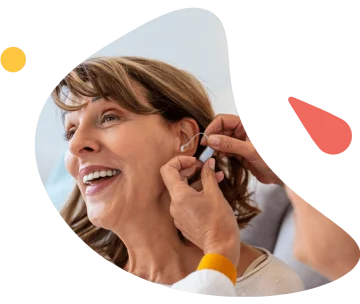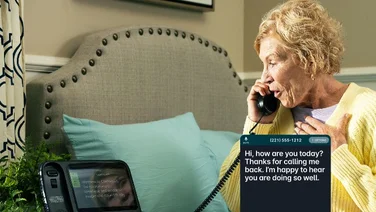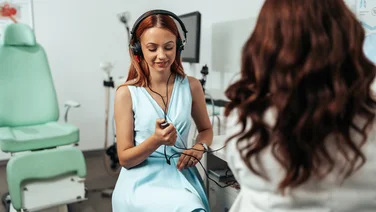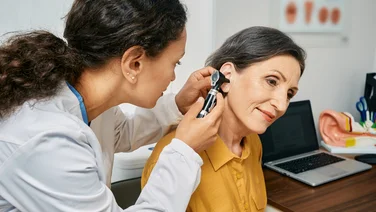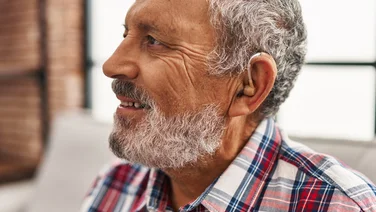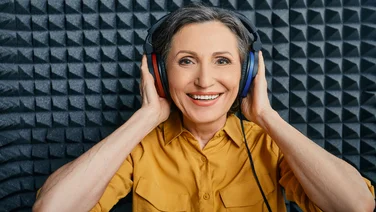It is not uncommon for infants and children to experience hearing loss at some time or another.
It is also not yet known how many babies are born in the US with hearing loss (congenital hearing loss), but estimates put the number between 1-5 in every 1,000.
By age three, 80% of children have experienced an ear infection, which can cause temporary hearing loss.
Around 12% of children aged six to 12 have noise-induced hearing loss, caused by repeated exposure to loud noise.
Any degree of hearing loss in infants and children can cause problems with speech development and learning, so it’s important it’s identified as early as possible.
Want to speak with a trained audiologist about your child's hearing?
Book a free consultation today
What are hearing tests for children?
Hearing tests are used to assess how well your child can hear, and they can identify if a child has hearing loss, the degree of the hearing loss, and its cause.

Around 98% of newborn babies have hearing screening after birth to check whether they have any signs of congenital hearing loss.
Hearing tests for babies and children are quick and painless.
Does my child need a hearing test?
Your baby’s hearing should ideally be tested before they leave the hospital after birth – or before they reach one month old.
If they don’t pass, it doesn’t necessarily mean they have serious hearing loss, but they should be retested and have a full hearing test as soon as possible – before they are three months old.
If your child is at risk of hearing loss later on (known as acquired hearing loss or delayed-onset hearing loss), it’s recommended that they have at least one hearing test by the time they reach two-and-a-half years of age.
Risk factors include: certain illnesses during infancy, neurological conditions, infections, and head trauma. Their risk is higher if you had certain infections or problems during pregnancy, or a difficult birth.
It is recommended that you test your child’s hearing at the ages of four, five, six, eight, and 10 – and more often if they have signs of hearing loss or a diagnosed hearing impairment.
Signs of hearing loss in children
Babies
- They don’t jolt or seem startled in reaction to loud sounds and noises
- By three months, they don’t react to a parent’s or caregiver’s voice
- By six months, they don’t turn their head in the direction of sound
- By 12 months, they are not imitating speech or producing simple words
Infants/young children
- Their speech is delayed or difficult to understand
- They don’t respond when you call their name (they might turn when they see you)
- They appear to not pay attention, or to be distracted
- They have difficulty following instructions
- They have behavioral problems
Older children/teens
- They have communication difficulties
- They struggle in school, present behavioral problems and seem distracted
- They have difficulty understanding speech and following conversations
- They turn up the volume on the TV or their music device
- They have trouble hearing high-pitched sounds
- They experience a ringing in their ears, called tinnitus
What hearing tests will my child have?
Depending on your child’s age and whether they are able to cooperate with the person conducting the test, they might have any of the tests seen below.
Newborn hearing screening tests include the otoacoustic emissions test (OAE test) and the auditory brainstem response test (ABR).
Otoacoustic emissions test (OAE test)
The OAE test is used to assess how well your child’s inner ear, or cochlea, works. It’s normally used to screen newborn babies for hearing loss.
Like with other hearing tests, a small probe is placed into your child’s ear, and sounds are played through it.
With standard hearing, when you hear a noise your inner ear produces very quiet sounds back to the middle ear in response to the noise. These are called otoacoustic emissions, or OAEs.
During an OAE test, the probe picks up these emissions when your child hears the sounds, and they’re recorded on a monitor.
Auditory brainstem response testing
This kind of test is used to detect problems with the way the inner ear sends signals to the brain and the brain’s response to them. They are normally part of the newborn hearing test that is used to screen for congenital hearing loss in babies.
The test involves placing earphones in your child’s ear canals and stickers on their forehead and behind their ears. The stickers have tiny electrodes attached to them, which are painless and very safe.
Clicking sounds pass through the headphones. The electrodes measure how your child’s auditory nerve – which sends sound signals to their brain – responds to the sound. The electrodes also measure the response of your child’s brain to the sounds.
The following tests can be conducted on older children as well as infants, as they don’t require your child to actively engage.
Tympanometry
This is a type of middle ear hearing test, and it’s used to check for any problems with your child’s eardrum.
It involves a small probe being placed into their ear canal. The probe is attached to a device that pushes air into the ear, and your child’s eardrum moves back and forth in response.
The way their eardrum moves is recorded on a graph, and your audiologist can use the readings to determine if there’s a problem with your child’s eardrum.
These include a tear or hole in the eardrum, fluid in the middle ear, a build-up of wax deep in the ear canal, or an infection.
Acoustic reflex measures
Also called middle ear muscle reflex (MEMR) test, this is another type of middle ear hearing test. It checks how your child’s ear responds to very loud sounds.
Inside the ear is a tiny muscle that tightens or contracts when you hear a loud noise. It’s an automatic response or a reflex, and the depth of movement this muscle has in response to noise is called an acoustic reflex.
In an acoustic reflex test, sounds will play through a probe inside your child’s ear. The audiologist will measure how loud the sound needs to be before their acoustic reflex to kicks in.
That can help identify how bad your child’s hearing loss is. If they have very severe hearing loss they might not have any acoustic reflexes.
Behavioral audiometry evaluation
This test involves a healthcare professional observing your child’s responses to sounds through play and interaction. The exact methods will vary depending on your infant or child’s age.

Speech and other sounds are played to your child, while the audiologist observes how they respond. For example:
- Infants may suck on a pacifier or turn toward the sound
- Younger children might repeat the word or select a picture
- School-aged children may raise their hand
The audiologist notes how your child responds according to certain measures, and will then interpret the results. They might recommend that your child has further hearing tests.
The following tests are carried out with children old enough to understand instructions and respond accordingly:
Pure-tone testing
This test involves your child wearing headphones that play beep sounds into each ear. When they hear a sound through the headphones, they indicate they’ve heard it usually by raising their hand or pressing a button.
The sounds are played at different levels of loudness and pitch. This helps to find the quietest sound they can hear at different pitches, in each ear.
This test is used in older children as it requires their response input.
Tuning fork testing
This is a simple test that can quickly signal what type of hearing loss your child might have. It’s sometimes called a Weber hearing test or a Rinne hearing test.
Sensorineural hearing loss occurs as a result of damage to a part of the inner ear, or the auditory nerve that carries sound waves to the brain. Conductive hearing loss occurs when sound waves are blocked from moving through the outer or inner ear, stopping sound from reaching the inner ear.
During a tuning fork hearing test, the audiologist will hold a a tuning fork (a two-pronged metal tool) behind your child’s ear, or on top of their head.
They’ll strike the tuning fork so it makes a sound. It’s completely painless and takes a few moments.
Your child is asked to tell the person conducting the test when they hear the sound, whether they hear it at different volumes, and whether they hear it in one ear or both ears.
How they respond when the fork is struck both behind their ear and on their head will help determine whether they have sensorineural or conductive hearing loss. It will also show if it affects one ear (unilateral) or both ears (bilateral).
Speech reception threshold testing
This test is similar to pure-tone testing, but rather than beep sounds it uses speech. It assesses how well your child recognizes speech and words. Your child will wear headphones and the audiologist will say different words at different volumes, which plays through the headphones.

When your child hears the word, they repeat it. This will help to identify if they have trouble hearing speech, or whether they struggle with particular speech sounds.
Children who are old enough to understand speech and words might have this hearing test.
Want to speak with a trained audiologist on your child's hearing?
Book a free consultation today
What happens after my child’s hearing test?
The tests your child take part in will depend entirely on different factors, including their age and whether they have experienced any symptoms or shown signs of hearing loss.
When they’ve undergone the hearing loss tests they need, the audiologist will look at all the results together to get a broad picture of:
- Whether your child has hearing loss
- What type of hearing loss they have
- What might be causing their hearing loss
- The degree of hearing loss
- Whether one or both of their ears are affected (unilateral or bilateral)
- Whether their hearing loss is likely to be permanent
The test results can also help identify what kind of treatment your child will likely to benefit from.
Treatment options will depend on all of these factors, but it will also take into account your preferences.
The United States Early Hearing Detection and Intervention (EHDI) program is aimed at diagnosing hearing loss in babies before they’re three months old, and starts treating babies who have permanent hearing loss by the time they are six months old.
Often, the best treatment will be to wear a hearing aid. These work by amplifying sound, making it louder, and enabling your child to hear more clearly.
If your child is diagnosed with very severe or profound hearing loss and hearing aids aren’t of benefit, they might be a candidate for a cochlear implant.
Depending on the cause of your child’s hearing loss, certain medications might help and, in some cases, surgery could be an option. Your audiologist or healthcare provider can discuss these options with you.
Your child might also benefit from additional support, such as speech and language therapy, educational support, and other types of therapies to help them learn key skills, such as social skills.
Early detection of hearing loss in children, along with access to the most appropriate services and support, can greatly improve your child’s development and help them to reach their full potential.
